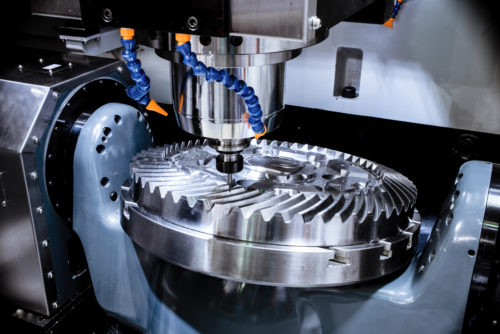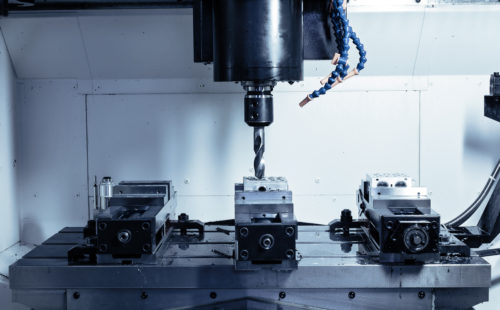Computer numerical control (CNC) milling is a highly precise subtractive machining process that enables manufacturers to produce high volumes of custom parts quickly and accurately. This process utilizes a combination of programmed computer code and multi-point cutting tools to selectively remove material from a substrate to shape the final part. Since CNC milling machines only need to be programmed once to create large volumes of identical parts, they offer excellent repeatability and are ideal for mass production, particularly in industries requiring high levels of precision.
How Does a CNC Mill Work and What Is a Milling Machine?
CNC milling machines function by affixing the workpiece to a table and shaping it with a cylindrical cutting tool. Guided by the programmed code, the cutting tool moves along multiple axes and creates holes, slots, and other details to create the desired finished product. Most CNC milling machines can accommodate both horizontal and vertical machining operations. Materials suited for CNC machining include:
- Wood

- Plastics
- Metals
- Glass
Unlike other drilling machines, which offer limited cutting angles, CNC milling machines are able to move along three to five different axes. As such, this process enables a high level of detail and precision even at high production speeds. CNC milling machines also require very little manual operation, significantly reducing the risk of human error.
Different Types of CNC Milling Machines
Depending on the specifications of the workpiece, there are several different types of CNC milling machines a manufacturer may use. These include:
Vertical Mill
This versatile type of milling machine moves along three axes. It is composed of a table and an arm, both of which are attached to a vertical column. The vertically oriented spindle is connected to the arm. There are several types of vertical mills such as turret vertical mills, in which the spindle remains stationary while the table moves along the x- and y-axes, and bed vertical mills, in which the spindle moves along the y-axis and the table moves along the x-axis. Regardless of the type of vertical mill, the arm will typically remain stationary while the table moves along the z-axis.
Horizontal Mill
Although they offer slightly less versatility than vertical mills, horizontal mills are ideal for applications involving long or heavy workpieces. These machines differ from vertical mills in that the spindle is horizontal rather than vertical. Additionally, universal horizontal milling machines can move along four axes, as they offer the advantage of rotating the table around the z-axis.
Knee Mill
Knee mills are unique in the method of table movement. With this type of machine, an adjustable knee is necessary to control the table’s movement along the column.
The Importance of CNC Milling
The ability to rapidly mass-produce precision parts is vital across an expansive array of industries. In the past, many machining methods were less efficient and more prone to error, which posed significant risks when producing components for industries such as aerospace and automotive.

However, the rise of CNC milling has made it possible to reduce these risks while simultaneously increasing efficiency. By utilizing computer programs to design and create components, manufacturers are able to take advantage of the speed and accuracy that digital technology provides. In addition to improving the consistent efficacy of the final components, CNC milling also lowers the cost of prototyping.
Kadco Ceramics: Your CNC Milling Experts
At Kadco Ceramics, we offer both three-axis and five-axis milling capabilities at our state-of-the-art facilities. This gives our expert machinists a great deal of flexibility, and enables us to meet the needs of customers across a range of industries. From ceramics and glass to composite structures, we are able to shape virtually any machinable material our customers require. Our diamond tooling technology offers even higher levels of precision, and our in-house design team can provide any assistance necessary to ensure a successful final product.
Since 1982, we have been dedicated to helping our customers find affordable, high-quality solutions for their production requirements. From material selection and design through to manufacturing, we continually prioritize open communication to ensure we meet our customer’s every need. Contact us today to learn more about how we can assist with your next CNC milling project.

 Thomas Registered Supplier
Thomas Registered Supplier